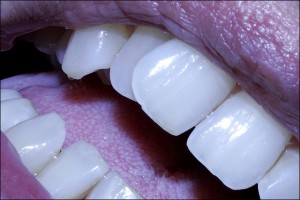By DiscoverTheOdds.com
Updated June 10, 2014
Have you ever wondered why some people enjoy certain foods, while others are absolutely repulsed by those very same foods? Or why some people enjoy drinking alcoholic beverages while others don’t? Part of the answer to these questions will literally leave you with your tongue hanging out. Modern scientific research has revealed that variations in taste and food and beverage consumption have a lot to do with the fact that some of us are born with what is called taste blindness.

Listen to the podcast episode, Are You Taste Blind? here or click here to listen in iTunes.
Contents
- 1 What is Taste Blindness?
- 2 Taste Blindness: What Are The Odds?
- 3 Taste Blindness and Tongue Anatomy
- 4 Are You a Nontaster, Medium Taster or a Supertaster?
- 5 The Tongue Test: How many fungiform papillae do you see?
- 6 Materials
- 7 Instructions
- 8 The PTC Test Strip Experiment: How bitter is it?
- 9 Materials
- 10 Instructions
- 11 Taste Blindness and Dietary Preferences
- 12 Nontasters Vs. Supertasters – Veggies, Spices and Spirits
- 13 Taste Blindness, Weight and BMI
- 14 Taste Blindness: A Few Closing Thoughts
- 15 Share this
What is Taste Blindness?
Taste blindness is a genetically programmed insensitivity to bitterness and strong tastes. Nontasters, or people who experience taste blindness, have fewer tastebuds on their tongues than other people do, so their sense of taste is not quite as strong. Thus, contrary to what the term may seem to suggest, taste blindness is not usually a complete inability to taste food, but rather it is a dampened perception of taste, with the most noted characteristic being an insensitivity to bitterness.  Interestingly, taste blindness was discovered by accident and only relatively recently at that. In 1931, while chemist A.F. Fox was working with phenylthiocarbamide (PTC), the PTC dust dispersed into the air, and the person next to A.F. Fox found the PTC to be bitter, while Fox himself didn’t taste anything. It was that incident in particular that marked a beginning of a research trajectory concerned with measuring taste blindness (typically through taste tests involving small amounts of the compounds PTC or propylthiouracil (PROP) and observations of individual tongue anatomy) and identifying differences in dietary preferences and disease risk that result from variations in taste sensitivity.
Interestingly, taste blindness was discovered by accident and only relatively recently at that. In 1931, while chemist A.F. Fox was working with phenylthiocarbamide (PTC), the PTC dust dispersed into the air, and the person next to A.F. Fox found the PTC to be bitter, while Fox himself didn’t taste anything. It was that incident in particular that marked a beginning of a research trajectory concerned with measuring taste blindness (typically through taste tests involving small amounts of the compounds PTC or propylthiouracil (PROP) and observations of individual tongue anatomy) and identifying differences in dietary preferences and disease risk that result from variations in taste sensitivity.
Taste Blindness: What Are The Odds?
Nontasters, or individuals born with taste blindness, make up roughly 25% of the American population. In other words, the odds of being taste blind are 1 in 4. Medium tasters comprise 50% of the population and supertasters make up another 25% of the population. Researchers have identified a number of distinctive characteristics associated with nontasters, from the anatomy of their tongues to dietary patterns to the diseases that nontasters are at greater risk of developing when compared to medium tasters and supertasters.
Taste Blindness and Tongue Anatomy
Taste buds are housed in mushroom-like structures on the tongue called fungiform papillae. Nontasters have fewer fungiform papillae on their tongues in comparison to medium tasters and super tasters and thus, nontasters have fewer tastebuds (and fewer oral pain fibers, which are found clustered around taste buds).
Are You a Nontaster, Medium Taster or a Supertaster?
Discover your taster status with one or both of these simple tests: 1) the tongue test or 2) the PTC test strip experiment.
Note: For the best results (and the most fun), conduct these experiments a partner.
The Tongue Test: How many fungiform papillae do you see?
Materials
- Blue food coloring
- Cottom swabs
- Reinforcement rings for hole-punched pages
- Magnifying glass
Instructions
- Swab the blue food coloring onto your tongue.
- Place a reinforcement ring onto your tongue.
- Look at your tongue up close in the mirror or with a magnifying glass and count the little bumps (the fungiform papillae) within the reinforcement ring. These dots will stand out against the blue food coloring.
- Based on the number of dots within the reinforcement ring on your tongue, determine your taster status:

- Fewer than 15: Nontaster
- 15-30: Medium (Normal) Taster
- Over 30: Supertaster
The PTC Test Strip Experiment: How bitter is it?
Materials
- PTC test strips
Instructions
- Place a PTC test stip on your tongue.
- Can you taste the bitterness of the strip? Based on your perception level of the strip’s bitter taste, determine you taster status:
- No bitter taste: Nontaster
- Mildly to somewhat bitter: Medium taster
- Very bitter: Supertaster
Taste Blindness and Dietary Preferences
Nontasters Vs. Supertasters – Veggies, Spices and Spirits
Research conducted by Dr. Linda Bartoshuk at the University of Florida (Boboila 2004) and others reveals that taste blindness may be both an advantage as well a risk factor for the development of certain diseases. On the one hand, nontasters are less sensitive to the bitter-tasting flavonoids found in many fruits and vegetables. This lower sensitivity may give nontasters an edge over supertasters when it comes to including enough fruits and vegetables in their diets. And because nontasters have fewer oral pain fibers, they typically relish the very spicy, hot foods that would bring medium and supertasters to utter tears. On the other hand, some studies have found that nontasters consume more alcoholic beverages (beer, wine, vodka, whiskey, etc.) per year than tasters do and nontasters have higher rates of alcohol addiction than tasters. It is thought that nontasters consume more alcohol because they experience lower levels of taste and oral pain perception, they are not as as bothered by the burning sensation of ethanol found in alcoholic beverages Additionally, at least one study has found that heavy smokers are significantly more likely to be nontasters than tasters. Nontasters appear to be less irritated by smoke and less sensitive to the bitterness of nicotine.
Taste Blindness, Weight and BMI
Scientists are also exploring the connection between taste sensitivity and weight. In one study, Dr. Beverly J. Tepper at Rutgers University found that women in their 40s who were nontasters appeared to eat more than supertasters. Nontasters had an average body-mass index (BMI) of nearly 30. A BMI of 30 or above is classified as obese. Medium tasters had an average BMI of 26.6 and supertasters have an average BMI of 23.5 (Flaherty 2007). What factors might be contributing to higher calorie consumption and BMI amounts among nontasters? Studies indicate that nontasters do not perceive the creaminess of high-fat foods as strongly as medium tasters and supertasters do. One study even found that while supertasters and medium tasters could tell a low-fat salad dressing from a high-fat dressing, nontasters could not. Nontasters also appear to have a lower sensitivity to sugar. For instance, a spoonful of sugar is only half as sweet to nontasters as it is to supertasters (Shmerling 2010).
Taste Blindness: A Few Closing Thoughts
Although our levels of taste sensitivity are determined by the genes we inherit, many other factors such as environment and choice, also influence the foods we eat, and the diseases we may ultimately develop. As children, we are exposed to a specific collections of foods and dishes defined by the households and communities in which we live; it is within that context that our individual preferences emerge and are refined as we grow. But no matter which foods appeared on our childhood dinner tables and no matter what our tongues may look like, we get to choose what we eat. And we can choose to make bold, revolutionary choices about what we eat and drink, paving the way to lower risk for disease and a lifestyle peppered with good old savory favorites and fresh, bold, culinary adventures into new realms of healthier cuisine. After all, there are hip new restaurants we can try, daring new cooking methods we can explore, nifty food nutrition labels we can read, temptation-ridden supermarket aisles we can avoid entirely, and all-time favorite family recipes we can tweak…well, at least just a little.
Sources
Boboila, C. (2004, Summer). From “Supertaster” to the Taste-blind. Yale Scientific Magazine, 77.4. Retrieved November 28, 2012. http://ysm.research.yale.edu//article.jsp?articleID=77
Flaherty, J. A. (2007). Are you a “super-taster”? Tufts University Health & Nutrition Letter, 25(2), 6-6.
Shmerling, R (2010). Are You a Supertaster? Check Your Genes. Harvard Health Publications. http://www.harvardhealthcontent.com/QuirkyBody/129,QB111510
Image Credits
Fungiform Papillae (Featured Image)/Image courtesy of Mike Joa/Flikr
Taste Blindness: Tongue Test – Are You a Nontaster, Normal Taster or Supertaster?/Image courtesy of the BBC
Further Reading
McDonald, J.H. (2011). PTC tasting: The myth. Myths of Human Genetics, pp. 54-60. Baltimore, Maryland: Sparky House Publishing. http://udel.edu/~mcdonald/mythptc.html.


